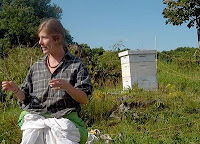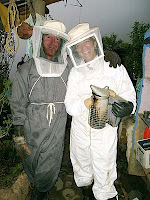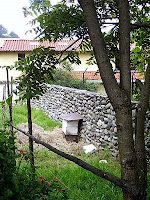Live foods, Enzymes and Raw Honey
It is not fresh news that the standard American diet (acronym is s.a.d.!) is not health  supportive. For all least four decades, we have been listening to the medical community’s advice about the quality and quantity of fat and fiber in our diets, and the increased incidence of heart disease, diabetes (particularly Type II, adult onset), cancer, and obesity among our population. As a result, many people have shifted their dietary intakes toward a plant-based diet which is rich in vitamins, minerals, fiber, and antioxidants, just to name a few nutrients. We have improved our diets “in layers,” meaning that the initial shift for some people is toward a plant-based diet. Subsequent layers or shifts include incorporating more organic produce and free-range poultry and meats, and what we call “superfoods.” Superfoods are called such because they are foods that are naturally rich in vitamins, minerals, and trace minerals. Blue-green algaes (e.g., chlorella and spirulina), seaweeds (e.g., kelp and dulse), bee pollen, and raw honey are examples of superfoods because of their extraordinarily generous contents of beneficial nutrients.
supportive. For all least four decades, we have been listening to the medical community’s advice about the quality and quantity of fat and fiber in our diets, and the increased incidence of heart disease, diabetes (particularly Type II, adult onset), cancer, and obesity among our population. As a result, many people have shifted their dietary intakes toward a plant-based diet which is rich in vitamins, minerals, fiber, and antioxidants, just to name a few nutrients. We have improved our diets “in layers,” meaning that the initial shift for some people is toward a plant-based diet. Subsequent layers or shifts include incorporating more organic produce and free-range poultry and meats, and what we call “superfoods.” Superfoods are called such because they are foods that are naturally rich in vitamins, minerals, and trace minerals. Blue-green algaes (e.g., chlorella and spirulina), seaweeds (e.g., kelp and dulse), bee pollen, and raw honey are examples of superfoods because of their extraordinarily generous contents of beneficial nutrients.
The most recent layer of awareness that has resulted in a shift in dietary improvement is the knowledge that certain foods contain highly beneficial, therapeutic enzymes. Many of us are returning to a way of eating that incorporates The ways of traditional or native peoples. Not only are our choices minimally processed (considered “whole foods”) and grown or raised organically, but equally importantly, many are vital, rich in, and alive with enzymes. In short, they are “live foods.” Even though a traditional society/culture might not know what an enzyme is and how it works, these people benefit from eating foods that are rich in enzymes. Their low incidence of modern food diseases and their longevity are the result of eating health-supportive diets. Lower stress levels as compared to those of people living in the modern world are a factor we can’t ignore as well.
Before we go further, we need to talk about what enzymes are. Enzymes are necessary for our bodies to function optimally. They are substances (protein specifically) that are able to simplify complex elements into simple elements. There are three classes of enzymes: digestive, metabolic, and food enzymes (which are present in raw foods). Enzymes are catalysts for biochemical processes and reactions in the body. When we are talking about digestion, this means that enzymes are necessary for the digestion of or breakdown of foods (like fats, carbohydrates, and proteins) into their simplest form. Enzymes make it possible for proteins to be broken down into amino acids and for complex carbohydrates to be broken down into simple sugars, for example. In addition to supporting digestion and making it possible, enzymes are also metabolic. They are involved in hundreds of metabolic reactions within our bodies which enable our complex biochemistries to work in the miraculous ways that they do, converting foods that we eat into renewing building products and energy.
All humans have what is called “enzyme potential,” meaning that we are born with an enzyme-making potential to satisfy the metabolic and digestive needs of the body. Nutrients that we ingest in the form of mostly raw and uncooked foods are also used to manufacture enzymes because our bodies’ enzyme reserves can’t always meet the demands for enzymes. Our bodies have evolved the natural ability to conserve enzymes by manufacturing them only on demand. We can also arrange for digestive enzymes to come into the body by taking digestive enzymes in capsule form. The virtues of enzymes and their significance in today’s diets are exclaimed/appreciated by noted doctors such as the late Dr. Edward Howell. A number of books, most notably Nourishing Traditions: The Cookbook that Challenges Politically Correct Nutrition and the Diet Dictocrats (1999), by Sally Fallon with Mary Enig, Ph.D. and Patient Heal Thyself (2003), by Jordan Rubin, N.M.D, C.N.C., are also emphasizing the importance of enzymes in the diet.
What are some sources of these beneficial enzymes? Raw honey is a food noted for its exceptionally high enzyme content. Other enzyme-rich raw foods include bee (flower) pollen, vegetables and fruits (especially avocado, banana, papaya, and pineapple), extra virgin olive oil, raw dairy foods, lacto-fermented dairy products like yogurt and kefir and cultured or fermented foods such as miso and sauerkraut. (Grains, nuts, legumes, and seeds are rich in enzymes as well as other nutrients, but they also contain enzyme inhibitors like phytic acid. This is why traditional cultures soak and sprout these foods in order to deactivate the enzyme inhibitors.) It needs to be emphasized here that these foods must not be heated so that the enzymes are viable and available. Here at Honey Gardens Apiaries, our honey is strictly raw and unheated, thus retaining the maximum enzyme content.
As mentioned above, because our honey is raw and unheated, the maximum enzyme content and health benefits are present for the consumer. Honey contains more than 75 different compounds (Buhner, Herbal Antibiotics, pp. 47 – 48), among them: enzymes, minerals and trace minerals, vitamins, proteins, carbohydrates, organic acids, and hydrogen peroxide. The enzymes in raw honey help to initiate the process of digestion and reduce the body’s need to produce digestive enzymes. Because of its high enzyme content, raw honey spares the enzyme reserves of the pancreas and other digestive organs. They won’t be constantly stimulated to produce and secrete various digestive enzymes. Wonderful long-term benefits of this enzyme-sparing activity are good health, increased longevity and energy, fewer illnesses, and a healthy immune system. In this way, one can see the importance of including raw, unheated honey in the diet.
The bees are starting to fly again. They are being checked to be sure they have enough food, and boxes of honey are being transferred from colonies that passed on and do not need this, to ones that survived the winter, and are light on their supply of honey and need more food. Signs of Spring are everywhere. The bears have come out of hibernation and are visiting the bee hives, too.
We appreciate your interest in and support of the bees and their work.
A feature from the series “ My Life in Food” that includes Honey Gardens will be on national TV on Saturday April 11 @ 6:30 pm on the Food Network.

“In August, the bees are working on the clover family plants and goldenrod. We are starting to see the first of the aster flowers. The vegetables on the farm that need to be pollinated have already been visited by the bees. At this time, it is important to think about whether the bees will have enough food to get through the winter. It has been a cool, wet summer, and I suspect that the bees have not made as much food here as in previous seasons.”
Thank you, Ann Kennedy for sharing your recipes with raw honey. Her daughter understands that truly raw honey is “pure gold”.
Gorgonzola Raw Honey Appetizers
–perfect with a strong cup of coffee, or good wine
Split open large, pitted fresh dates. Spread with raw honey, top with a small piece of gorgonzola (or other sharp flavored cheese) and a raw almond.
Carrot Honey Spread
Finely grate 4 – 5 peeled carrots and stir in about 1/4 cup (or more to taste) raw honey. Stir in 1/4 cup natural chunky style peanut butter, and 1/8 teaspoon curry powder. Season with salt as needed.
Honey Breakfast Bruschetta Spread with French Toast
Coarsely chop 1 cup pecans and 1/2 cup almonds. Combine. Melt 2 T butter and stir into nuts. Sprinkle lightly with cinnamon and nutmeg. Stir in raw honey until there is a good spreading consistency. Set aside. Slice a baguette on the diagonal, dip each piece in a beaten egg (about 2 pieces per egg), and cook in butter as you would French toast. Top with honey spread and drizzle with a tiny bit of cream if desired.


